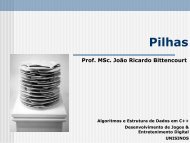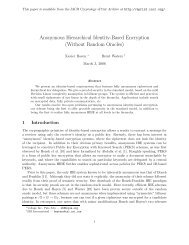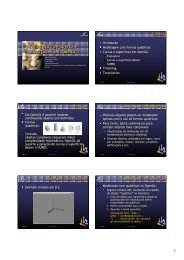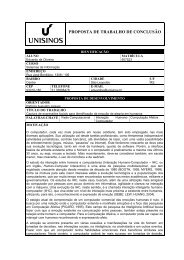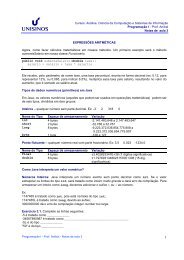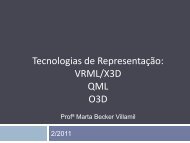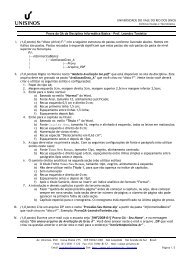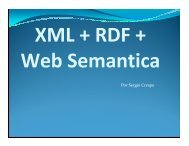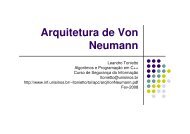Resumos - Unisinos
Resumos - Unisinos
Resumos - Unisinos
Create successful ePaper yourself
Turn your PDF publications into a flip-book with our unique Google optimized e-Paper software.
Trabalho 1 <br />
Disciplina: Metodologia de Pesquisa <br />
Data: 01/03/2013 Semestre: 2013/I <br />
Prof.: Patrícia Jaques M. e Christopher Pohlmann <br />
Exercício 1: <br />
Para fazer em aula: <br />
Identifique nos resumos de artigos científicos abaixo quais trechos descrevem as <br />
seguintes partes do trabalho científico do qual se tratam: <br />
• Contexto e/ou Tema <br />
• Conceitos Básicos <br />
• Problema <br />
• Hipótese <br />
• Objetivo <br />
• Método <br />
• Justificativa <br />
• Resultados alcançados <br />
OBS: Pode ser que um artigo não apresente todos os itens acima e/ou <br />
apresente em outra ordem. <br />
Resumo 1: <br />
Fonte: http://homepages.dcc.ufmg.br/~mirella/doku.php?id=dcc851:main <br />
HeapSort: Optimized Sorting Algorithm<br />
Many computer scientists consider sorting the most fundamental problem<br />
in algorithms. Traditional algorithms, such as Insertion Sort, Selection<br />
Sort and Bubble Sort, have quadratic complexity - Θ(n 2 ). In this paper,<br />
we propose the Heapsort, a comparison-based sorting algorithm. Heapsort<br />
inserts the input list elements into a heap data structure and elementary<br />
implementations require two arrays - one to hold the heap and one to<br />
hold the sorted elements. Although we can classify Heapsort as part of the<br />
selection sort algorithm, it has an impressive worst-case runtime of Θ(n<br />
log n). Indeed, our experiments show a considerable performance gain<br />
when comparing Heapsort against the traditional algorithms over different<br />
datasets.
Trabalho 1 <br />
Disciplina: Metodologia de Pesquisa <br />
Data: 01/03/2013 Semestre: 2013/I <br />
Prof.: Patrícia Jaques M. e Christopher Pohlmann <br />
Resumo 2: <br />
Fonte: SANTOS et al 2008 em http://homepages.dcc.ufmg.br/~mirella/pdf/<br />
SemAc-Artigos-doc.pdf.<br />
A Web é abundante em páginas que armazenam dados de forma implícita. Em<br />
muitos casos, estes dados estão presentes em textos semiestruturados sem a presença<br />
de delimitadores explícitos e organizados em uma estrutura também implícita. Este<br />
artigo apresenta uma nova abordagem para extração em textos semi-estruturados<br />
baseada em Modelos de Markov Ocultos (Hidden Markov Models - HMM). Ao<br />
contrário de outros trabalhos baseados em HMM, a abordagem proposta dá ênfase à<br />
extração de metadados, além dos dados propriamente ditos. Esta abordagem consiste<br />
no uso de uma estrutura aninhada de HMMs, onde um HMM principal identifica os<br />
atributos no texto e HMMs internos, um para cada atributo, identificam os dados e<br />
metadados. Os HMMs são gerados a partir de um treinamento com uma fração de<br />
amostras da base a ser extraída. Os experimentos realizados com anúncios de<br />
classificados retirados da Web mostram que o processo de extração alcança qualidade<br />
acima de 0,97 com a medida F, mesmo se esta fração de treinamento é pequena.<br />
Resumo 3: <br />
Fonte: ZHANG et al 2006 em http://homepages.dcc.ufmg.br/~mirella/pdf/<br />
SemAc-Artigos-doc.pdf<br />
Finding useful patterns in large datasets has attracted considerable interest<br />
recently, and one of the most widely studied problems in this area is the<br />
identification of clusters, or densely populated regions, in a multi-dimensional<br />
dataset. Prior work does not adequately address the problem of large datasets<br />
and minimization of I/O costs. This paper presents a data clustering method<br />
named BIRCH (Balanced Iterative Reducing and Clustering using Hierarchies),<br />
and demonstrates that it is especially suitable for very large databases. BIRCH<br />
incrementally and dynamically clusters incoming multi-dimensional metric<br />
data points to try to produce the best quality clustering with the available<br />
resources (i.e., available memory and time constraints). BIRCH can typically<br />
find a good clustering with a single scan of the data, and improve the quality<br />
further with a few additional scans. BIRCH is also the first clustering algorithm<br />
proposed in the database area to handle “noise” (data points that are not part of<br />
the underlying pattern) effectively. We evaluate BIRCH’s time/space<br />
efficiency, data input order sensitivity, and clustering quality through several<br />
experiments. We also present a performance comparisons of BIRCH versus<br />
CLARAS, a clustering method proposed recently for large datasets, and show<br />
that BIRCH is consistently superior. [ ZHANG et al – SIGMOD 1996 ]





